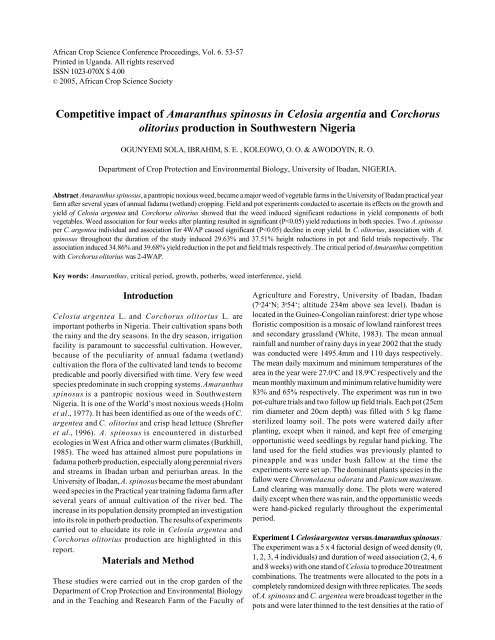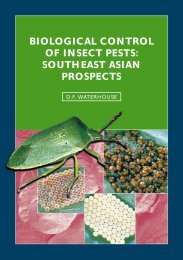Adobe PDF - EcoPort
Adobe PDF - EcoPort
Adobe PDF - EcoPort
You also want an ePaper? Increase the reach of your titles
YUMPU automatically turns print PDFs into web optimized ePapers that Google loves.
African Crop Science Conference Proceedings, Vol. 6. 53-57<br />
Printed in Uganda. All rights reserved<br />
ISSN 1023-070X $ 4.00<br />
© 2005, African Crop Science Society<br />
Competitive impact of Amaranthus spinosus in Celosia argentia and Corchorus<br />
olitorius production in Southwestern Nigeria<br />
OGUNYEMI SOLA, IBRAHIM, S. E. , KOLEOWO, O. O. & AWODOYIN, R. O.<br />
Department of Crop Protection and Environmental Biology, University of Ibadan, NIGERIA.<br />
Abstract Amaranthus spinosus, a pantropic noxious weed, became a major weed of vegetable farms in the University of Ibadan practical year<br />
farm after several years of annual fadama (wetland) cropping. Field and pot experiments conducted to ascertain its effects on the growth and<br />
yield of Celosia argentea and Corchorus olitorius showed that the weed induced significant reductions in yield components of both<br />
vegetables. Weed association for four weeks after planting resulted in significant (P
54<br />
1:0, 1:1, 1:2, 1:3 and 1:4 of C. argentea to A. spinosus. A distance<br />
of 6 cm was maintained between and among stands of combining<br />
species. In the field trial, the same treatment combinations<br />
were established but in a randomized complete block design<br />
with three replicates. Each block was 2 x 1 m 2 . The plots were<br />
bed-raised with hoes. The plots were 0.5m apart. Seeds of C.<br />
argentea were drilled at 15cm spacing between rows and later<br />
thinned to 15cm within rows to have a plant density of 444,444<br />
plants per hectare.. Seeds of A. spinosus were ring-broadcast<br />
at 6cm intervals and later thinned to the required density ratios<br />
at 2 WAP. The performance of both C. argentea and A. spinosus<br />
was monitored in terms of plant height, stem diameter, number<br />
of leaves/plant, leaf area and plant biomass at harvest.<br />
S. OGUNYEMI et al.<br />
Experiment II. Corchorus olitorius versus Amaranthus<br />
spinosus: The design of the experiment followed the two<br />
component model as described by Hall et al. (1992). The 1 st<br />
component is the maximum length of time weeds emerging<br />
with the crop can remain before they reduce yield (weedy and<br />
subsequently weedfree, wd-wf) and the 2 nd component is the<br />
length of time that a crop must be kept weed-free after planting<br />
so that weeds emerging later do not reduce yield (weedfree<br />
and subsequently weedy, wf-wd). A. spinosus was allowed to<br />
associate with C. olitorius for varying periods of time (as<br />
indicated in Table 1). The same treatments were established in<br />
pots and in the field. In the pots, two seeds of C. olitorius and<br />
4 of A. spinosus were sown in each pot to give a ratio of 1:2 crop<br />
to weed. Weed-crop distance was 8cm in all pots. The pot trial<br />
was a completely randomized design while the field was a<br />
randomized complete block design with 3 replicates. Each block<br />
was (12 x 2) m 2 and each plot was 2 x 1 m 2 . C. olitorious was<br />
planted in rows with 30cm inter-row spacing and later thinned<br />
to the required population densities. Seeds of A. spinosus were<br />
planted in rows 8cm from C. olitorious and a crop to weed ratio<br />
of 1:2 was also maintained. Data recorded for C. olitorius at 12<br />
weeks after planting (WAP) were plant height, stem diameter,<br />
number of leaves per plant and plant dry weight at harvest. All<br />
dry weights were obtained by oven drying harvested materials<br />
for 48 hours at 70 0 C before weighing. All data collected were<br />
subjected to ANOVA and mean differences were compared<br />
using DMRT at 5% level of probability (Gomez and Gomez,<br />
1983).<br />
Results<br />
Density and Duration of Interaction between A. spinosus and<br />
C. argentea. In the presentation of results the four control<br />
treatments were pooled into one treatment (D0). Different<br />
densities of A. spinosus growing in association with Celosia<br />
argentea exerted significant pressure on the performance of<br />
the potherb. In the pot trial, regardless of duration of weed<br />
association, density presssure caused significant reduction in<br />
the stem height and the number of leaves per plant of Celosia<br />
argentea (Table 2). However, the treatments were not<br />
significantly different with regards to stem diameter. In the field<br />
trial, A. spinosus induced significant reduction in stem height,<br />
stem diameter and number of leaves per plant of Celosia<br />
argentea (Table 2). Dry matter production was also<br />
significantly reduced by increasing weed density regardless<br />
of duration of competition especially in the field trial, although<br />
fresh weight of Celosia a rgentea was not significantly affected<br />
by interference from A. spinosus (Table 3). It was informative<br />
that dry weight suffered as high as 50% reduction when four A.<br />
spinosus competed with one Celosia argentea for eight weeks.<br />
Critical period of interference of A. spinosus with Corchorus<br />
olitorius. In the two trials at 12 WAP the C. olitorius exposed<br />
to weedy treatment (Treatment 7) had significantly reduced<br />
height (Table 4). They were similar to plants that were weedy<br />
for at least four weeks (Treatments 3, 4, 5 & 6). The weedfree<br />
plants (Treatment 1) and those that were weedy in the first<br />
two weeks and subsequently weedfree (Treatment 2) had<br />
good height growth and were similar to those plants that<br />
were weedfree for at least two weeks (Treatments 8, 9, 10, 11<br />
& 12). The treatments followed the same trend in terms of all<br />
growth parameters considered. With regards to dry matter<br />
accumulation in the field trial, plants that were weedy for at<br />
least the first 2 weeks (Treatments 1 & 2) and those that<br />
were weedfree for at least the first four weeks (Treatments 9,<br />
10, 11 & 12) were similar and had significantly (P
Competitive impact of Amaranthus spinosus and Corchorus olitorius in Nigeria. 55
56<br />
S. OGUNYEMI et al.
Competitive impact of Amaranthus spinosus and Corchorus olitorius in Nigeria. 57<br />
Amaranthus spinosus and Celosia argentea are members<br />
of the same family. They probably have similar growth<br />
requirements, hence the keen competition between the two<br />
species for nutrients and probably moisture. The duration<br />
of competition probably contributed to the competitive<br />
effects as weed density and duration of association induced<br />
significant reduction in the stem diameter. In the field, stem<br />
diameter was significantly reduced beyond three weeds/<br />
plant and four weeks of competitive interaction. Ogunyemi<br />
et al.(2001) showed similar reduction in crop performance<br />
when Solanum nigrum grew in association with Amaranthus<br />
cruentus. Ogunyemi et al (2000) also obtained similar results<br />
in the study of the competitive interaction between<br />
Amaranthus spinosus and Glycine max.<br />
The performance of Corchorus olitorius was adversely<br />
affected by competition from Amaranthus spinosus.<br />
It is clear from the study that the critical period of interference<br />
of A. spinosus with C. olitorius lies between the first 2-4<br />
weeks of growth. This agrees with Biswas (1986) who<br />
reported 2WAP as the critical period of weed competition<br />
for Corchorus olitorius. Smith (1974) reported similar results<br />
for rice in competition with Echinochloa crus-galli. Abamu<br />
(1995) also reported that reduction in rice grain dry weight<br />
resulted from increase in the time of crop-weed association.<br />
In both potherbs, the parameters plant height, stem diameter<br />
and number of leaves are of great value in the<br />
marketability of the vegetables. Any weed interaction that<br />
causes significant reductions in these parameters deserves<br />
serious attention. Vegetable growers do not normally sell<br />
by dry weight or even fresh weight in Nigeria, but by size as<br />
indicated by height and leafiness. The subsequent presence<br />
of weed after weedfree period (wf-wd) from four weeks<br />
onward probably enhanced the yield of C. olitorius by<br />
ameliorating crop environment, especially if moisture is not<br />
limiting. Awodoyin (2000) reported that at 1600 hours in 5<br />
cm soil depth the presence of weed on soil surface compared<br />
to weedfree plot had 8.8% reduction on soil temperature.<br />
References<br />
Abamu, J.A. 1995. Evaluating a crop-weed simulation model as<br />
a tool for weed management in irrigated transplanted rice<br />
(Oryza sativa). Ph.D thesis submitted to the faculty of the<br />
graduate school, University of the Philippines, Los Banos.<br />
174pp.<br />
Awodoyin, R. O. 2000. Biology of sicklepod [Senna obtusifolia<br />
(L.) Irwin and Barneby] and its potential in weed control.<br />
Ph.D Thesis, University of Ibadan, Nigeria. 247pp.<br />
Biswas, D.K. 1996. Integrated weed control in Jute. In<br />
Abstract of papers, India Soc. of Weed Science. p68.<br />
Burkhill, J.M. 1985. Flora of West Tropical Africa (1 st edition,<br />
London) Crown Agent, Vol. 2:346-352.<br />
Gomez, K. A., & Gomez, A.A. 1984. Statistical procedure for<br />
agricultural Research. John Wiley and Sons. 2nd Edition<br />
680pp.<br />
Hall, M.R., Swanton, J.C. & Anderson, G.W. 1992. The critical<br />
period of wed control in grain corn ( Zea may). Weed Science<br />
40, 441-447.<br />
Holm, L.G., Plucknett, D.l., Panchap, J.O. & Herbeger, J.P.<br />
(1997). The world’s worst weeds: distribution and biology.<br />
University press, Hawaii, Honolulu, 602p. Horticulture<br />
Agencyof International development, Washington.<br />
Ogunyemi, Sola, Awodoyin, R. O. & Otu, N. A. 2000.<br />
Chemical Control of Ageratum conyzoides, Amaranthus<br />
spinosus and Cyperus rotundus in soyabeans [ Glycine max<br />
(L.) Merril.]. Journal of Tropical Forest Resources 16(1):143-<br />
151.<br />
Ogunyemi, Sola, Ngwanyi, C.V. & Awodoyin, R.O. 2002.<br />
Interference of Solanum nigrum L. with the performance of<br />
Amaranthus cruentus L. Nigerian Journal of Plant Protection<br />
19, 56-64<br />
Shrefter, J.W., Stall, W.M. & Dusky, J.A.1996. Spiny<br />
Amaranth ( Amaranthus spinosus L.), a serious competitor<br />
to crisped head lettuce (Lactuca sativa L.) Hortscience<br />
31, 347-348.<br />
Smith(Jr.), R.J. 1974. Competition of Barnyard grass with<br />
Rice cultivars. Weed Science 22, 423-426.






